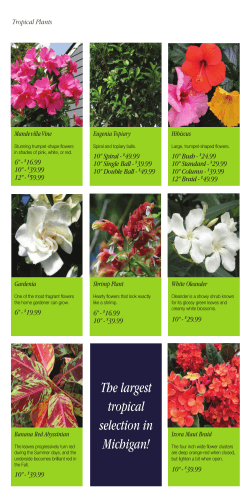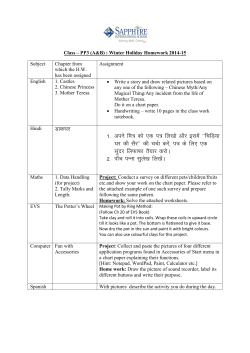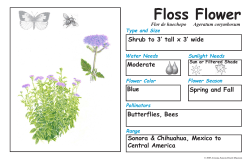
Climbing Plants - Friends School Plant Sale
42 Friends School Plant Sale • May 8–10, 2015 www.FriendsSchoolPlantSale.com Climbing Plants Annual Vines C013 Love-in-a-Puff ß Cardiospermum halicacabum Long, tubular, dark purple flowers with parasolshaped rosy calyces and heart-shaped green leaves. Beautiful and vigorous in a sunny location. Climbs by twining. 10’h Í∏† $3.00—3.5” pot Small white flowers followed by light green inflated pods containing seeds marked with a distinct little heart. Quick-growing vines with pretty, lacy foliage are excellent for covering wire fences. Climbs by tendrils. 10’h Í∏ $7.00—4.5” plantable pot Black-Eyed Susan Vine C014 Moonflower, Climbing ß Ipomoea noctiflora alba Thunbergia alata Winsome twiner or trailer with masses of flowers with flat, open faces and dark eyes. Í∏† White 5-6” trumpets unfurl as evening approaches releasing a lovely fragance. The blooms gently spiral closed with the rising sun. Vigorous twining climber. 10–30’h ÍΩ¥ $7.00—4.5” plantable pot $3.00—3.5” pot: C002 Susie ß—Large 1.5” orange blooms. 4–5’h $7.00—4.5” plantable pot: Passion Flower Passiflora C003 African Sunset ß—Distinctive warm terra cotta shades. Vigorous. 10’h C004 Arizona Dark Red ß—Deep persimmon-red. 6–8’h C005 Sunny Lemon Star—Lemony yellow. 10’h C006 Sunny Susy Red Orange ß—Deep redorange. 6–8’h Outlandish flowers late summer through fall with lush, dark green foliage. Can be grown in a tub and allowed to spend winter dormant in a frost-free basement. Prefers well-drained soil and plenty of sun. Climbs by tendrils. Í $3.00—3.5” pot: C015 Blue P. caerulea ß—Blue and white flowers late summer through fall. 15’h † C007 Bleeding Heart Vine ◊ Clerodendrum Delectum Red Showy clusters of red flowers with lavender bracts on a tropical vine. It can be over-wintered indoors as a house plant. This West African vine will repeatedly reward you with massive clusters of white and scarlet flowers. Climbs by twining. 10–12’h Í∏Ω∫˙ $15.00—5.25” pot C008 Canary Bird Vine Tropaeolum peregrinum Bright yellow flowers and deeply lobed foliage. The flowers are said to look like canaries, but some see them as troll dolls with wild yellow hair. Blooms all summer into fall. Climbs by long leaf stalks. 12’h Í∏ $3.00—3.5” pot BASKETS , Trumpet Creeper Perennial Vines C001 Bell Vine, Purple ß Rhodochiton astrosanguineum Purple Rain See also HANGING We accept cash, checks, Amex, Visa, MasterCard & Discover page 22 $10.00—4” pot: C016 Giant Granadilla P. quadrangularis ß— Fragrant 5” deep red flowers with a frilly, fancy white and purple banded center. A too-small pot encourages flowering. Sunny south window as a houseplant. Fast-growing. It would be a challenge to get its nine-pound passion fruit. 30–50’h in Minnesota. C017 Snapdragon, Climbing Asarina purpusii Victoria Falls Vibrant 2” magenta-purple trumpets with lime bracts and lovely green-gray foliage. Works on a trellis or in a mixed container. Blooms early summer until frost. Twining. 8–10’h Í∏ $7.00—4.5” plantable pot C009 Candy Corn Flag ß Manettia luteorubra Sweet Pea, Heirloom Lathyrus odoratus Blooms resemble candy corn, orange with yellow tips. A fun novelty for small trellises, basket or pots. More vigorous in part shade. Twines. 3–4’h Í∏† $3.00—3.5” pot C018 King Edward VII ◊ ß—Fragrant, deep C010 Cup and Saucer Vine Cobaea scandens Striking 2” flowers that change from green to lovely violet. If planted in a sheltered spot, the flowers continue after early frosts. Graceful climber, suitable for tub culture. Climbs by tendrils. 25’h Í∏ $3.00—3.5” pot C011 Firecracker Vine ß Mina lobata Exotic Love In full sun, one plant can easily produce several hundred arching sprays of aligned flowers in a spectacular color combination, August through frost. Each 1” flower begins rich red and matures to orange, then to yellow and finally to white. All colors are out at once. Self twining; more restrained in part shade. 20’h Í∏†˙ $3.00—3.5” pot Intense, unique fragrance. Climbs by leaf tendrils. Í $7.00—4.5” plantable pot: crimson summer blooms, introduced in 1903 by Henry Eckford, the Scottish hybridizer of grandiflora sweet peas that were very popular cut flowers and flower show exhibits. Almost the only sweet pea from that era still grown, it won the RHS Award of Garden Merit in 1995. 4–6’h C019 Lady Grisel Hamilton ◊ ß—Her Ladyship is 120 years old with simple fragrant pale bluelavender flowers. Tolerates warm weather. Prefers rich soil. 5–6’h See also vegetables, BEANS and BIT TER MELON , page 37, and MALABAR SPINACH , page 38 C012 Hyacinth Bean ß Dolichos lablab Ruby Moon Rose-purple fragrant wisteria-like flowers midsummer through fall bloom. Elegant purple-tinged heart-shaped leaves and glossy magenta-purple seed pods in fall. Vigorous, fast-growing twining climber that needs a strong trellis. Grown as food in tropical areas, the young shoots, immature pods, and flowers are edible, but dried pods and seeds can cause stomach upset without special treatment in cooking. 10–20’h ÍÇ˙¥ $7.00—4.5” plantable pot If you save Box Tops throughout the year, you can bring them to the plant sale. (A collection can is located at the the Info Desk under the central staircase.) Thanks for your help! Community multiple perspectives C020 Bittersweet Celastrus scandens Autumn Revolution This introduction from Bailey Nurseries is a revolution in bittersweet. Not only selffruiting, it produces berries twice the normal size, every year. Bright red to orange berries are wonderful in dried arrangements. Vigorous and twining variety of the Minnesota native climber. 15–25’h Í¥ $17.00—1 gal. pot C021 Bleeding Heart, Climbing Adlumia fungosa Pearly pink spurred blossoms. Biennial vine for shade that climbs by leaf tendrils. Native to Appalachia and the north shore of Lake Superior in Minnesota. Horticultural source. 6–10’h Í∏˜ $3.00—2.5” pot Chocolate Vine Akebia Perfect for growing on fences, pergolas or by the patio where the scent will pervade. Twining. Í∏ $9.00—1 quart pot: C022 Five-Leaf A. quinata—An eye-catching climber with clusters of rounded leaves and racemes of captivating chocolate-purple blooms with a spicy fragrance. 30’h C023 Three-Leaf A. trifoliata—Elegant twining vine from China with large attractive three-part leaves and faintly scented dark-purple flowers in mid-spring. Combines nicely with a clematis. 4–6’h Honeysuckle continued $8.00—1 quart pot (continued): C062 John Clayton—Discovered by a member of the Virginia Native Plant Society, this honeysuckle has lovely, soft-yellow, tubular flowers that are slightly fragrant. 10–20’h C063 Honeysuckle, Variegated Lonicera periclymenum Harlequin ß Foliage is green edged in cream, frequently with pink highlights. Yellow and pink fragrant flowers from June to October. Compact and slower growing. Moist, well-drained soil. Twining. 10–12’h Í∏Ω˙ç¥ $3.00—3.5” pot Hops Humulus lupulus This fast-growing vine has maple-like leaves. Pine-scented greenish flowers resembling cones are attractive to butterflies. The young shoots are edible like asparagus. Dried, the flowers are also a key ingredient in beer brewing. Dies back to the ground each winter. Strong spreader from the roots. Twining. Í∏∫ $6.50—3” pot: C064 Cascade ◊—Aroma-type hops Clematis see page 43 with moderate bitterness, often used in West Coast ales. Considered the most popular hops in North America. 20’h by 10’w C065 Columbus ◊—Excellent for bitter ales and American pale ales, and can be dramatic when dry hopped. High alpha acids. 20’h C066 Nugget—A great bittering hop with a heavy herbal aroma. Gold leaves. 25’h C057 Dutchman’s Pipe Aristolochia durior C067 Magnum ◊ ß—Citrusy and Large, heart-shaped dark green leaves, great screening. Excellent larval food for butterflies. Small, yellow-brown flowers look like a clay pipe. Tolerant of shade and dry soil; spreads from the roots. Over time will provide a complete screen of green. Climbs by tendrils. Syn. A. macrophylla. 20–30’h Í∏Ω∫¥ $16.00—1 gal. pot Honeysuckle, Dropmore Scarlet Lonicera x brownii Blooms, more coral-scarlet than scarlet, are excellent for attracting hummingbirds and orioles. Good for fences or trellises. Twining. Bred in Manitoba. 12’h ÍΩ˙¥ $14.00—1 gal. pot: spicy flavor, commonly used as a base bittering hop in many beer recipes. Also known as Hallertau Magnum. 20–25’h C068 Mount Hood ◊ ß—Developed in Oregon, this triploid aromatic hop variety is part of the Hallertau family of hops. 15–20’h C069 Willamette—Fruity and floral. Great for American pale and brown ales, and English-style ales. 15–25’h C070 Hydrangea, Climbing Hydrangea petiolaris C058 $4.00—3.5” pot C060 $13.00—1 gal. pot Clusters of fragrant flowers with showy white bracts. Early summer blooming. Very slow to establish; worth the wait. From Japan. Self-clinging by aerial rootlets. 30’h Í∏¥ $8.00—1 quart pot Honeysuckle, Trumpet C071 Hydrangea-Vine, Lonicera sempervirens Japanese ◊ A vigorous grower popular with hummingbirds and nectar-seeking moths. Orange-red berries, which many birds relish, appear after the flowers. Beautiful blue-green foliage. It needs at least a halfday of sun for good blooms. Climbs by twining. Í∏Ω˙¥ Schizophragma hydrangeoides Rose Sensation $8.00—1 quart pot: C061 Blanche Sandman—Deep rose Late spring to mid-summer lacy flower clusters, shading white to pink. If the suggested height sounds daunting (perhaps optimistic), it can be cut back in late winter to control the ultimate size. Vigorous vine that clings by aerial rootlets. 40–50’h ∏∫ $11.00—5.25” pot flowers blooming sporadically from May until frost. 12’h How to make sure your plants are free of neonic pesticides Grow plants yourself from organic seeds or plants, or buy organically grown plants. Ask your sources of nonorganic plants: • Have you ever used neonics on this plant or its soil? • If you got the seed, cutting, or young plant from elsewhere, has it ever had neonics used on it? Remember: neonics stay in the plant and in the soil. www.FriendsSchoolPlantSale.com May 8–10, 2015 • Friends School Plant Sale 43 Climbing Plants Clematis Clematis C072 Ivy, Boston Parthenocissus tricuspidata Í¥ See more CLEMATIS, page 6 (unusual plants) Clematis climbs by leaf stems that grab anything less than a half-inch in diameter. The plants like full sun with their roots protected from the hottest midday rays. Those that tolerate a bit more shade have been marked with ∏ in the description. Originally from Japan, not Boston. A dense, selfclinging vine. Brilliant orange color in fall. Berries favored by birds. This vine put the ivy in Ivy League. Self-clinging by glue pads. 70’h Í∏ $3.00—2.5” pot All clematis are toxic to people and pets. Deer resistant. C073 Monkshood Vine Ampelopsis aconitifolia $2.00—2.5” pot: $16.00—1 gal. pot (continued): C024 Vanilla-Scented C. recta ß—With an explosion C039 Duchess of Edinburgh ◊ ß—Pure white Finely cut foliage makes a lovely cover for walls and fences. Clusters of non-showy, greenish flowers in late summer, followed by bunches of round, bluish fruits that mature to orange-yellow in autumn. Climbs by tendrils. 15–25’h Í∏ $7.00—1 quart pot C074 Porcelain Berry Ampelopsis brevipedunculata Elegans Vigorous vine, clinging by tendrils, is covered in small tri-lobed leaves with splashes of pink and white, and pink young shoots. Yellow fall foliage and bright blue to pink-purple berries. Best fruiting with more sun, best variegation in light shade. Can be cut to the ground in late winter to control size. 15’h Í∏ $8.00—1 quart pot C075 Sweet Pea, Everlasting ß Lathyrus latifolius Pearl Mix Pink, red or white blooms with winged stems. Plant in a protected area. Climbs by tendrils. 6’h Í∏¥ $2.00—2.5” pot Trumpet Creeper Campsis radicans Large trumpets in summer. Excellent for attracting hummingbirds, good for butterflies. Vigorous vine; not for small spaces. May die back in severe winters, but regrows from the ground. Climbs by aerial roots. Not recommended to grow up the side of a house or garage because it can grow through building materials. Í $2.00—2.5” pot: C076 Orange ß—30’h ∫˙ $8.00—1 quart pot: C077 Red Sunset—Fiery red trumpet-shaped flowers with rich green foliage. It flowers almost all summer and is a favorite of hummingbirds. 30’h ∫˙ Wisteria Wisteria macrostachya Charming flowers in long hanging clusters in May or early June, followed by fruit pods that remain throughout winter. Locally selected to do well in our climate. Grow only on a strong arbor or pergola. Twining. Í∏¥ $17.00—1 gal. pot: C078 Summer Cascade ◊—The hardiest of them all at the of U of M’s Landscape Arboretum with impressive racemes that open bluish purple and fade as summer wears on. Stems twine through slats or around pickets. Nice seedpods. Deer-resistant. Original name: Betty Matthews, named for a long-time White Bear Lake gardener whose garden was its first home. 15–25’h $28.00—2 gal. pot: C079 Blue Moon—Large, fragrant lilac-blue flowers on long racemes in early summer followed by repeat blooms twice more. Introduced by Rice Creek Gardens in Blaine. This wisteria can bloom up to three times a year when planted in full sun. These are two year old plants from vegetative propagation of the original Blue Moon plant. 15–30’h of white star-like blossoms and a wonderful vanilla aroma, this energetic plant is covered with flowers in June and July. Beautiful foliage, too. Grown from seed saved from a historic St. Anthony Park garden, given to us by Mary Lerman. Group 3. 6’h by 6’w $3.00—3.5” pot: C025 Virgin’s Bower C. virginiana ß—Native vine with long festoons of small white flowers in summer. Very interesting seed heads. Free flowering. Suitable as a cut flower. Good to ramble over slopes. Seed from Winona County, Minn. Can be pruned any time; treat as Group 3 for a bushier plant (or don’t prune and allow it to ramble). 12–20’h Í∏˜ $4.00—2.5” pot: C026 Sweet Autumn C. terniflora—White, 1–2” open flowers in clusters. Hardy, vigorous and easy to grow; free flowering and very fragrant August– September. Seldom needs pruning, but when desired, prune in early spring when the buds begin to swell. Syn. C. paniculata. Group 3. ***** 15–20’h $10.00—3.5” pot: C027 Betina C. alpina ◊—Many fragrant, pendant 2” violet-blue flowers from mid-spring to summer. Showy seed heads follow. Perfect for covering fences, shrubs and small trees. Mulch thickly to conserve moisture in summer and to provide winter protection. Group 1. 8–12’h Í∏ C028 Betty Risdon ◊—Stunning, with 6-8” creamy pinkish blooms edged in a deeper pink-red and bright yellow stamens. Early. Plant in a somewhat shady, sheltered spot for best flower color. Group 1. 8–10’h Í∏ C029 Bluebill C. pitcheri ◊—Long-lasting, nodding, urn-shaped flowers, usually purple but sometimes dark red, from June–August, dying back to the ground in the fall so no pruning is needed. 8–10’h Í∏ C030 Lagoon C. macropetala ◊—Spring-flowering with dark-blue nodding multi-petalled bells. Vigorous and tolerates shade and a north exposure. Little or no pruning, tidy in spring. Group 1. 8–10’h Í∏ C031 Stolwijk Gold C. alpina—Superimposed against a dark background, this yellow-leafed clematis offers you beguiling contrast. Nodding, 2” bellshaped blue flowers appear in May, changing to fluffy silver seed heads for fall interest. Group 1. 6–8’h C032 Teshio—Double 3–5” lavender-blue rosettes open up late spring to early summer. Japanese cultivar. Group 2. 7’h $12.00—5.25” pot: C033 Sweet Summer Love—Cranberry-purple, cherryvanilla scented flowers will bloom more than a month before its cousin Sweet Autumn and keep blooming. Group 3. 10–15’h $16.00—1 gal. pot: C034 Bourbon ß—Vibrant 5–6” red flowers with Thank you, Master Gardeners, for volunteering at the sale! Master Gardeners will be on hand throughout the sale to answer questions (located near the central stairway). Many are from Ramsey County: www.co.ramsey.mn.us/mastergardener To find your local Master Gardener program: www.extension.umn.edu/offices taxi-yellow anthers from June through early August. A good candidate for containers, due to its diminutive size. Group 2. 4–6’h C035 Cardinal Wyszynski ß—Vigorous international gold award winner that glows with 6–8” deep purplish red flowers from July–September. Group 2. 8–10’h C036 Corrine ◊ ß—White with a stripe of clear pink on each petal, darker in the center fading towards the tip. Soft pink anthers. Heavy bloomer in June, repeating in August. Group 2. 6’h C037 Diamantina ◊ ß—Deep violet-blue 4–6” double flowers with silver-green central petals when they first open. Pom-pom blooms can last up to a month. Introduced and named a Top Ten new plant at the Chelsea Flower Show in 2010. Reblooms in late summer to early fall. Excellent cut flower. Group 2. 6–8’h C038 Diana’s Delight ß—Dark and light lavenderblue blossoms with creamy centers. Blooms May–June and September. Group 2. 4–6’h Í∏ Pruning Clematis double 4–6” flowers with soft yellow anthers. Blooms May–June and again in September. Group 2. 8’h C040 Elsa Späth ß—Rich lavender, overlapping to give somewhat of a double appearance. Red anthers. Very free flowering from late spring to summer. a.k.a. Xerxes. Group 1. 6–10’h C041 Fleuri ◊ ß—Deep violet 5” flowers with a magenta-red stripe. White and magenta anthers. Blooms May and August. Compact plants. Group 3. 4’h C042 Gillian Blades ß—Stunning, 5–8” ruffled white flowers in late spring and again in late summer. Group 2. 6–8’h C043 Huldine ß—Blooms in July from new growth and continues through October with sparkling white flowers accented in yellow. Group 3. 12–20’h C044 Jackman C. viticella ß—Most popular clematis. Profuse bloomer with 4” dark velvet purple flowers. Blooms mid and late summer. Old variety, dating back to 1860. Group 3. ***** 10’h C045 Kilian Donahue ß—Flowers open ruby red at the center, turning to brilliant fuchsia with orchid edges. Then flowers become lavender with a pink bar, sporting dancing white anthers, burgundytipped. Early and repeat bloomer. Group 2. 8–10’h C046 Mrs. Robert Brydon C. heracleifolia ß— Vigorous, nonclimbing vine with many small bluish-white flowers late summer through fall. Can be tied onto a trellis, allowed to cascade down a hill, or used as a ground cover. Group 3. 10’h C047 Niobe ß—Best red clematis with 6” flowers that open nearly black, then mature to dark ruby-red with brilliantly contrasting yellow stamens. Very free flowering. Originated in Poland. Seldom needs pruning, but if you do, prune in April. Blooms May to September. Group 2 or 3. 8–10’h C048 Polish Spirit C. viticella ß—Queen of the Vines, one of the most prolific blooming of clematis. Masses of rich violet-blue, 2–4” flowers. Excellent for use along fences or on a trellis. Strong stems make good cut flowers. Mulch heavily around the roots. Prune hard in early spring. Group 3. 15’h C049 Purpurea Plena Elegans C. viticella ◊ ß— Double, 2–4” reddish-purple petticoat flowers bloom in mid-summer. A good candidate for growing through shrubs and small trees as well as on other supports. An heirloom variety also called Italian Clematis and Etoile Violette. Awarded the Royal Horticultural Society’s Award of Garden Merit. Blooms June–September. Group 3. 8–12’h C050 Rebecca ß—5–7” red blooms with a creamy center May–June, reblooming in August. Group 2. 6–8’h Í∏ C051 Rhapsody ß—Sapphire blue petals that deepen in color as they age. Creamy yellow anthers. Blooms July through September. Group 3. 8–10’h C052 Roguchi C. integrifolia x durandii ß—Exquisite nodding bells in the deepest shade of inky bluefrom summer until fall. Glossy seedheads in the later fall garden. Group 3. ***** 8’h C053 Rosemoor ß—Rose-red 6” blooms with yellow anthers. Flowers on both old and new wood from May–September. Group 2. 6–8’h C054 Sapphire Indigo ß—Cross-shaped, long-blooming sapphire blue flowers on a compact vine that can be grown unsupported as a groundcover. Supported, it grows taller. Unusual and lovely in a hanging basket or container. Group 2. 3–4’h Í∏ C055 Sugar Candy ß—Single 7” pink-mauve flower with a darker pink center bar and yellow anthers. Free-flowering repeat-bloomer once established. Flowers on old wood in early summer and again on new wood in the late summer, so tidy it in the spring, wait for it to bloom, then prune back the top one third of some stems to encourage new growth and flowering for a second show. Group 2. 6–10’h Í∏ C056 Sunset ß—Velvety, deep rosy fuchsia, 5–7” single flowers with wide purple-edged petals and cream-yellow centers. Blooms profusely May–June and again in September. Group 2. 6–10’h It may seem intimidating, but pruning the various types of clematis is really a matter of common sense. One bit of vintage clematis pruning advice is “If it blooms before June, don’t prune.” Pruning groups include the early-flowering varieties (Group 1), the repeat bloomers (Group 2) and the large-flowered vines that usually bloom in summer or later (Group 3). GROUP 1 Blooms in spring on last year’s growth. After flowering, prune lightly to shape vine if needed. GROUP 2 Repeat bloomers, first flowering on last year’s growth, then reblooming on new growth. If needed, lightly trim in early spring when buds swell. After the first bloom, again lightly prune to increase later flowers. GROUP 3 Summer flowers and later, on new growth. Prune severely in early spring when new buds begin to swell, cutting stems back to 12–14” from the base of the vine to produce good growth and encourage abundant flowering. “If it blooms before June, don’t prune.” See page 46 for an article on gardening with clematis.
© Copyright 2025










